Development of an Intelligent Service Platform for a Poultry House Facility Environment Based on the Internet of Things
Abstract
:1. Introduction
2. Design of Platform System Structure
2.1. Data Acquisition Scheme
2.2. Data Flow and Storage Scheme
3. System Design and Implementation
3.1. Real-Time Data Collection and Display
3.2. Production Data Management
3.3. Data Analysis
3.4. Basic Information Management and System Management
3.5. System Implementation
4. Results and Discussions
4.1. Data Display Interface on Web Page
4.2. Comprehensive Analysis of Historical Data
fixed costs + variable costs,
4.3. Data Collection Volume and Validity
4.4. Discussion
5. Conclusions
Author Contributions
Funding
Institutional Review Board Statement
Data Availability Statement
Acknowledgments
Conflicts of Interest
Abbreviations
| Symbols and Expressions | |
| CMR | cumulative mortality rate |
| DAQ | data acquisition |
| EPR | egg production rate |
| IaaS | Infrastructure as a Service |
| IoT | Internet of things |
| IQR | interquartile range |
| LabVIEW | Laboratory Virtual Instrument Engineering Workbench |
| LAN | local area network |
| LoRa | Long Range Radio |
| MQTT | Message Queuing Telemetry Transport |
| PaaS | Platform as a Service |
| PPMU | portable particulate monitoring unit |
| PLF | precision livestock farming |
| P and L | profit and loss |
| RFID | Radio Frequency Identification |
| ResNet | residual network |
| SaaS | Software as a Service |
| Q1 | the lower quartile |
| Q3 | the upper quartile |
| WSNs | wireless sensor nodes |
References
- Alaa, M.; Zaidan, A.A.; Zaidan, B.B.; Talal, M.; Kiah, M.L.M. A review of smart home applications based on Internet of Things. J. Netw. Comput. Appl. 2017, 97, 48–65. [Google Scholar] [CrossRef]
- Chavhan, S.; Gupta, D.; Chandana, B.N.; Khanna, A.; Rodrigues, J.J.P.C. IoT-Based Context-Aware Intelligent Public Transport System in a Metropolitan Area. IEEE Internet Things J. 2020, 7, 6023–6034. [Google Scholar] [CrossRef]
- Anand, D.; Singh, A.; Alsubhi, K.; Goyal, N.; Abdrabou, A.; Vidyarthi, A.; Rodrigues, J.J.P.C. A Smart Cloud and IoVT-Based Kernel Adaptive Filtering Framework for Parking Prediction. IEEE T Intell. Transp. 2023, 24, 2737–2745. [Google Scholar] [CrossRef]
- Khullar, V.; Singh, H.P.; Miro, Y.; Anand, D.; Mohamed, H.G.; Gupta, D.; Kumar, N.; Goyal, N. IoT Fog-Enabled Multi-Node Centralized Ecosystem for Real Time Screening and Monitoring of Health Information. Appl. Sci. 2022, 12, 9845. [Google Scholar] [CrossRef]
- Schmidt, T.B.; Lancaster, J.M.; Psota, E.; Mote, B.E.; Hulbert, L.E.; Holliday, A.; Woiwode, R.; Perez, L.C. Evaluation of a novel computer vision-based livestock monitoring system to identify and track specific behaviors of individual nursery pigs within a group-housed environment. Transl. Anim. Sci. 2022, 6, txac82. [Google Scholar] [CrossRef] [PubMed]
- Song, Y.; Bi, J.; Wang, X. Design and implementation of intelligent monitoring system for agricultural environment in IoT. Internet Things-Neth. 2024, 25, 101029. [Google Scholar] [CrossRef]
- Rastegari, H.; Nadi, F.; Lam, S.S.; Ikhwanuddin, M.; Kasan, N.A.; Rahmat, R.F.; Mahari, W.A.W. Internet of Things in aquaculture: A review of the challenges and potential solutions based on current and future trends. Smart Agric. Technol. 2023, 4, 100187. [Google Scholar] [CrossRef]
- Kodali, R.K.; Rajanarayanan, S.C.; Boppana, L. IoT Based Weather Monitoring and Notification System for Greenhouses; IEEE: Chennai, India, 2019; pp. 342–345. [Google Scholar]
- Astill, J.; Dara, R.A.; Fraser, E.D.G.; Roberts, B.; Sharif, S. Smart poultry management: Smart sensors, big data, and the internet of things. Comput. Electron. Agr. 2020, 170, 105291. [Google Scholar] [CrossRef]
- Du, X.D.; Carpentier, L.; Teng, G.H.; Liu, M.L.; Wang, C.Y.; Norton, T. Assessment of Laying Hens’ Thermal Comfort Using Sound Technology. Sensors 2020, 20, 473. [Google Scholar] [CrossRef]
- Peña Fernández, A.; Norton, T.; Tullo, E.; van Hertem, T.; Youssef, A.; Exadaktylos, V.; Vranken, E.; Guarino, M.; Berckmans, D. Real-time monitoring of broiler flock’s welfare status using camera-based technology. Biosyst. Eng. 2018, 173, 103–114. [Google Scholar] [CrossRef]
- Zhao, Y.; Xin, H.; Dong, B. Use of infrared thermography to assess laying-hen feather coverage. Poultry Sci. 2013, 92, 295–302. [Google Scholar] [CrossRef]
- Okada, H.; Suzuki, K.; Kenji, T.; Itoh, T. Applicability of Wireless Activity Sensor Network to Avian Influenza Monitoring System in Poultry Farms. J. Sens. Technol. 2014, 04, 18–23. [Google Scholar] [CrossRef]
- Arshad, J.; Rehman, A.U.; Othman, M.T.B.; Ahmad, M.; Tariq, H.B.; Khalid, M.A.; Moosa, M.A.R.; Shafiq, M.; Hamam, H. Deployment of Wireless Sensor Network and IoT Platform to Implement an Intelligent Animal Monitoring System. Sustainability 2022, 14, 6249. [Google Scholar] [CrossRef]
- Li, H.; Wang, H.; Yin, W.; Li, Y.; Qian, Y.; Hu, F. Development of a remote monitoring system for Henhouse environment based on IoT technology. Future Internet 2015, 7, 329–341. [Google Scholar] [CrossRef]
- Todero, E.L.; de Santana Weizenmann, G. Remote Monitoring System for Aviaries. In Proceedings of the 14th IEEE International Conference on Industry Applications(INDUSCON), Sao Paulo, Brazil, 15–18 December 2021; pp. 308–315. [Google Scholar]
- Yu, L.; Teng, G.; Li, B.; Zhang, Y.; Lao, F.; Xing, Y. A Remote-Monitoring System for Poultry Production Management using a 3G-Based Network. Appl. Eng. Agric. 2013, 29, 583–601. [Google Scholar] [CrossRef]
- Fengdan, L.; Ligen, Y.; Guanghui, T.; Junjun, Z. Design and implementation of 3G+VPN monitoring and control system for protected agriculture. J. China Agric. Univ. 2011, 16, 155–159, (In Chinese with English Abstract). [Google Scholar]
- Saraswathi, S.; Hong-Geun, K.; Jangwoo, P.; Yongyun, C. A study on decision support system based on the fuzzy logic approach for the livestock service management. Int. J. Serv. Technol. Manag. 2017, 23, 83–100. [Google Scholar]
- Chen, H.Q.; Xin, H.; Teng, G.H.; Meng, C.Y.; Du, X.D.; Mao, T.T.; Wang, C. Cloud-based data management system for automatic real-time data acquisition from large-scale laying-hen farms. Int. J. Agr. Biol. Eng. 2016, 9, 106–115. [Google Scholar] [CrossRef]
- Zheng, H.; Zhang, T.; Fang, C.; Zeng, J.; Yang, X. Design and Implementation of Poultry Farming Information Management System Based on Cloud Database. Animals 2021, 11, 900. [Google Scholar] [CrossRef]
- Wu, C.; Buyya, R.K.U.; Ramamohanarao, K. Cloud Pricing Models: Taxonomy, Survey, and Interdisciplinary Challenges. ACM Comput. Surv. 2020, 52, 1–36. [Google Scholar] [CrossRef]
- Choudhary, A.; Verma, P.K.; Rai, P. Comparative Study of Various Cloud Service Providers: A Review. In Proceedings of the 2022 International Conference on Power, Energy, Control and Transmission Systems (ICPECTS), Chennai, India, 8–9 December 2022; pp. 1–8. [Google Scholar]
- Mansouri, Y.; Toosi, A.; Buyya, R. Data Storage Management in Cloud Environments: Taxonomy, Survey, and Future Directions. ACM Comput. Surv. 2018, 50, 1–51. [Google Scholar] [CrossRef]
- Zhang, H.; Chen, C. Design of Sick Chicken Automatic Detection System Based on Improved Residual Network; IEEE: Chongqing, China, 2020; Volume 1, pp. 2480–2485. [Google Scholar]
- Pereira, W.F.; Fonseca, L.D.S.; Putti, F.F.; Góes, B.C.; Naves, L.D.P. Environmental monitoring in a poultry farm using an instrument developed with the internet of things concept. Comput. Electron. Agr. 2020, 170, 105257. [Google Scholar] [CrossRef]
- Sun, X.; Pan, Z.; Bertino, E. Intelligent Poultry Environment Control System Based on Internet of Things; Springer International Publishing AG: Cham, Switzerland, 2018; Volume 11067, pp. 407–417. [Google Scholar]
- Luo, J.; Zhao, C.; Chen, Q.; Li, G. Using deep belief network to construct the agricultural information system based on Internet of Things. J. Supercomput. 2022, 78, 379–405. [Google Scholar] [CrossRef]
- Zhu, P.; Teng, G.; Liu, J.; Chen, W.; Wu, J. Visualization Evaluation Method for Hygrothermal Environment Comfort of Broiler Breeder. China Poult. 2023, 45, 86–94, (In Chinese with English Abstract). [Google Scholar] [CrossRef]
- Du, X.D.; Lao, F.D.; Teng, G.H. A Sound Source Localisation Analytical Method for Monitoring the Abnormal Night Vocalisations of Poultry. Sensors 2018, 18, 2906. [Google Scholar] [CrossRef] [PubMed]
- Du, X.; Teng, G. An automatic detection method for abnormal laying hen activities using a 3D depth camera. Eng. Agr.-Jaboticabal 2021, 41, 263–270. [Google Scholar] [CrossRef]
- Goswami, P.; Faujdar, N.; Debnath, S.; Khan, A.K.; Singh, G. Investigation on storage level data integrity strategies in cloud computing: Classification, security obstructions, challenges and vulnerability. J. Cloud Comput. Adv. Syst. Appl. 2024, 13, 23–45. [Google Scholar] [CrossRef]
- Lu, Y.; Yang, X.; E, L.; Fang, Z.; Li, Y.; Liang, C.; Shi, Z.; Wang, C. Characterizing a Year-Round Particulate Matter Concentration and Variation under Different Environmental Controls in a Naturally Ventilated Dairy Barn. Agriculture 2023, 13, 902. [Google Scholar] [CrossRef]
- Mateo-Fornés, J.; Pagès-Bernaus, A.; Plà-Aragonés, L.M.; Castells-Gasia, J.P.; Babot-Gaspa, D. An Internet of Things Platform Based on Microservices and Cloud Paradigms for Livestock. Sensors 2021, 21, 5949. [Google Scholar] [CrossRef]
- Lashari, M.H.; Karim, S.; Alhussein, M.; Hoshu, A.A.; Aurangzeb, K.; Anwar, M.S. Internet of Things-based sustainable environment management for large indoor facilities. Peerj Comput. Sci. 2023, 9, e1623. [Google Scholar] [CrossRef]
- Mahbub, M. A smart farming concept based on smart embedded electronics, internet of things and wireless sensor network. Internet Things 2020, 9, 100161. [Google Scholar] [CrossRef]
- Zhang, H.; Qian, S. Network Architecture for Intelligent Identification of Faults in Rabbit Farm Environment Monitoring Based on a Biological Neural Network Model. Comput. Intel. Neurosc. 2022, 2022, 6377043. [Google Scholar] [CrossRef]
- Neethirajan, S.; Kemp, B. Digital Twins in Livestock Farming. Animals 2021, 11, 1008. [Google Scholar] [CrossRef]
- Costa, A.; Ferrari, S.; Guarino, M. Yearly emission factors of ammonia and particulate matter from three laying-hen housing systems. Anim. Prod. Sci. 2012, 52, 1089. [Google Scholar] [CrossRef]
- Wang, Y.; Wang, C.Y.; Li, B.M. Determination of carbon dioxide concentration standards and minimum ventilation rates of layer house in winter. Trans. Chin. Soc. Agric. Eng. 2017, 33, 240–244, (In Chinese with English Abstract). [Google Scholar]
- Yin, H.; Wu, Z.; Wu, J.; Chen, Y.; Chen, M.; Luo, S.; Gao, L.; Hassan, S.G. A Multistep Interval Prediction Method Combining Environmental Variables and Attention Mechanism for Egg Production Rate. Agriculture 2023, 13, 1255. [Google Scholar] [CrossRef]
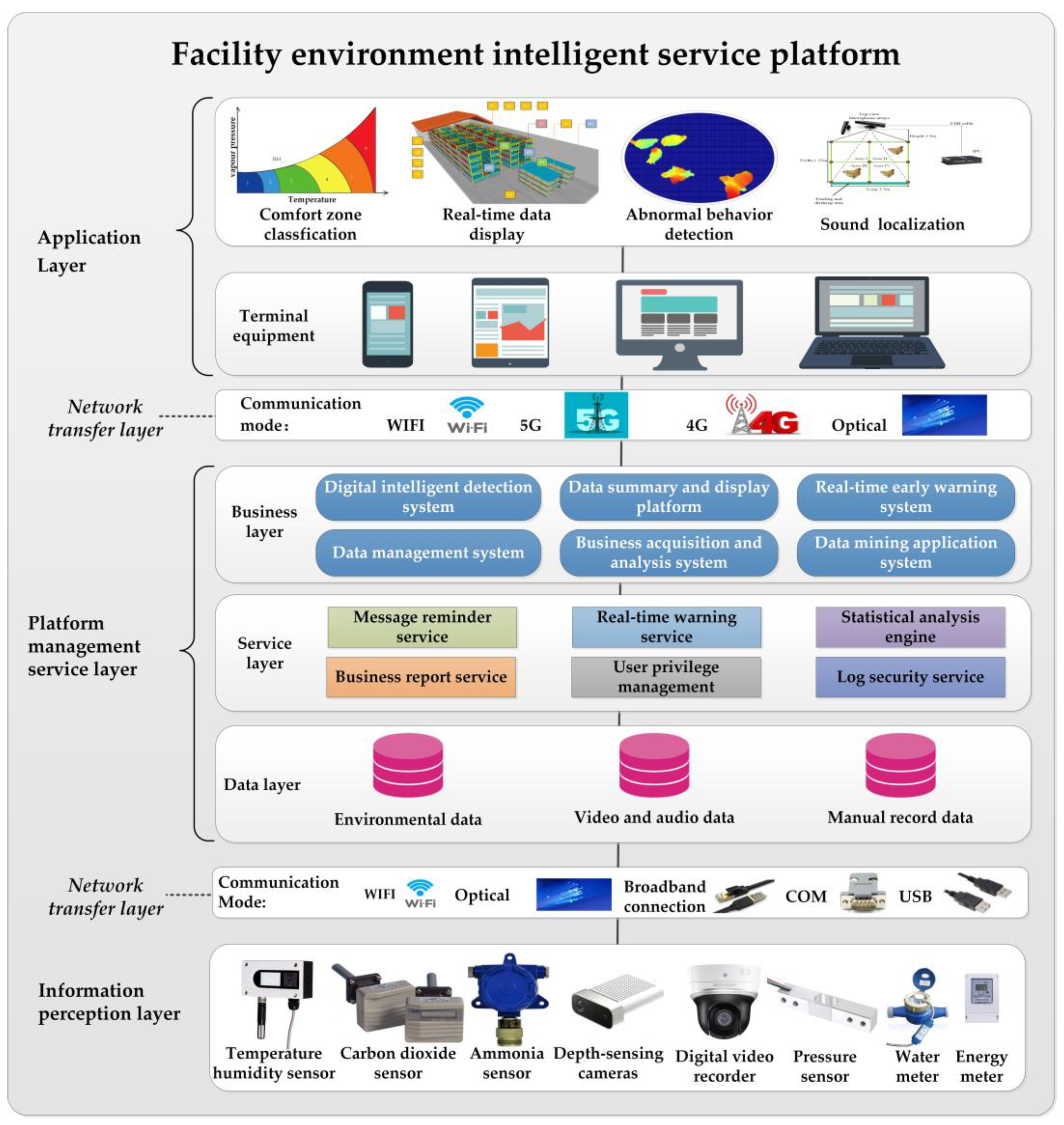

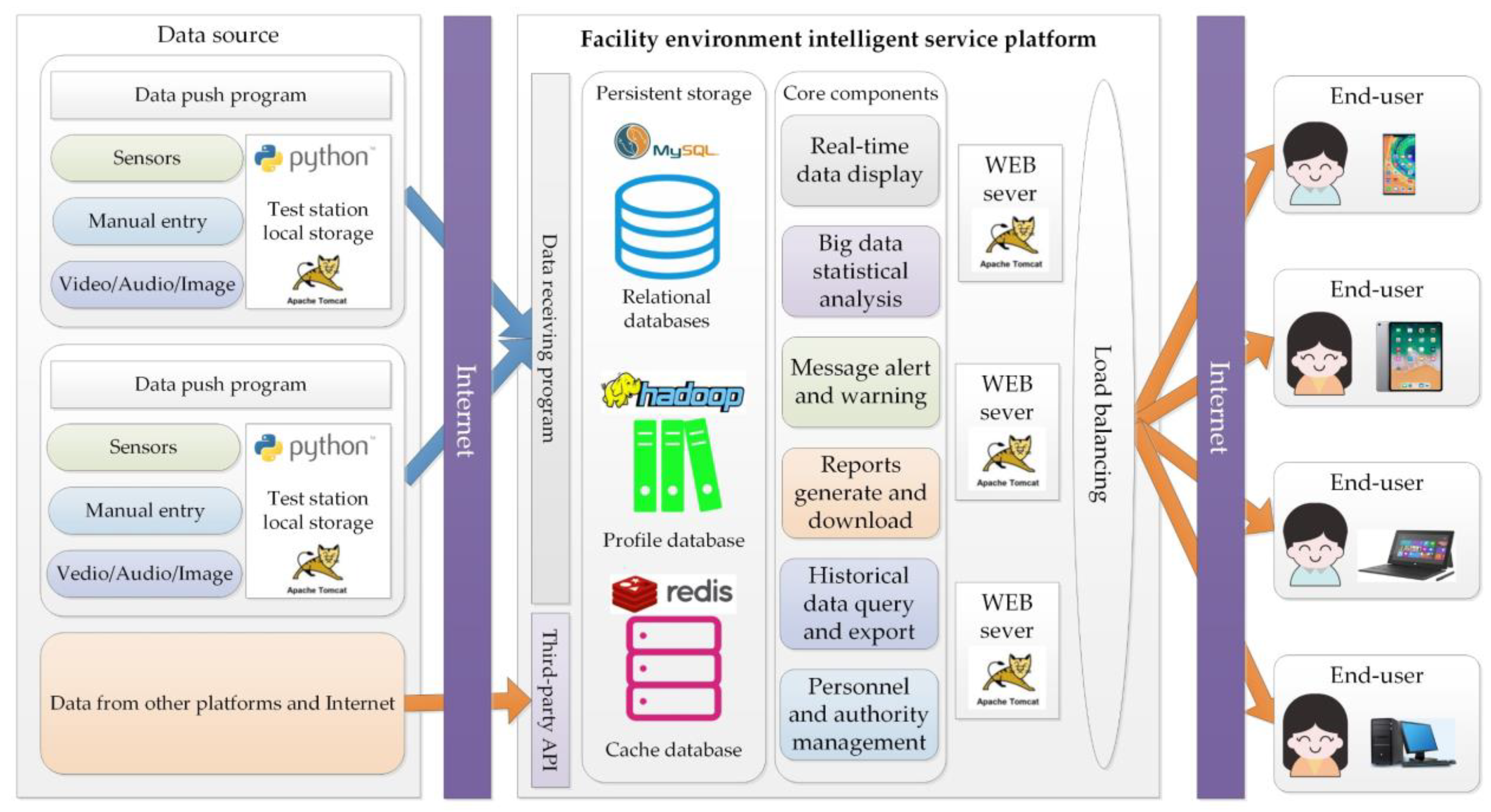
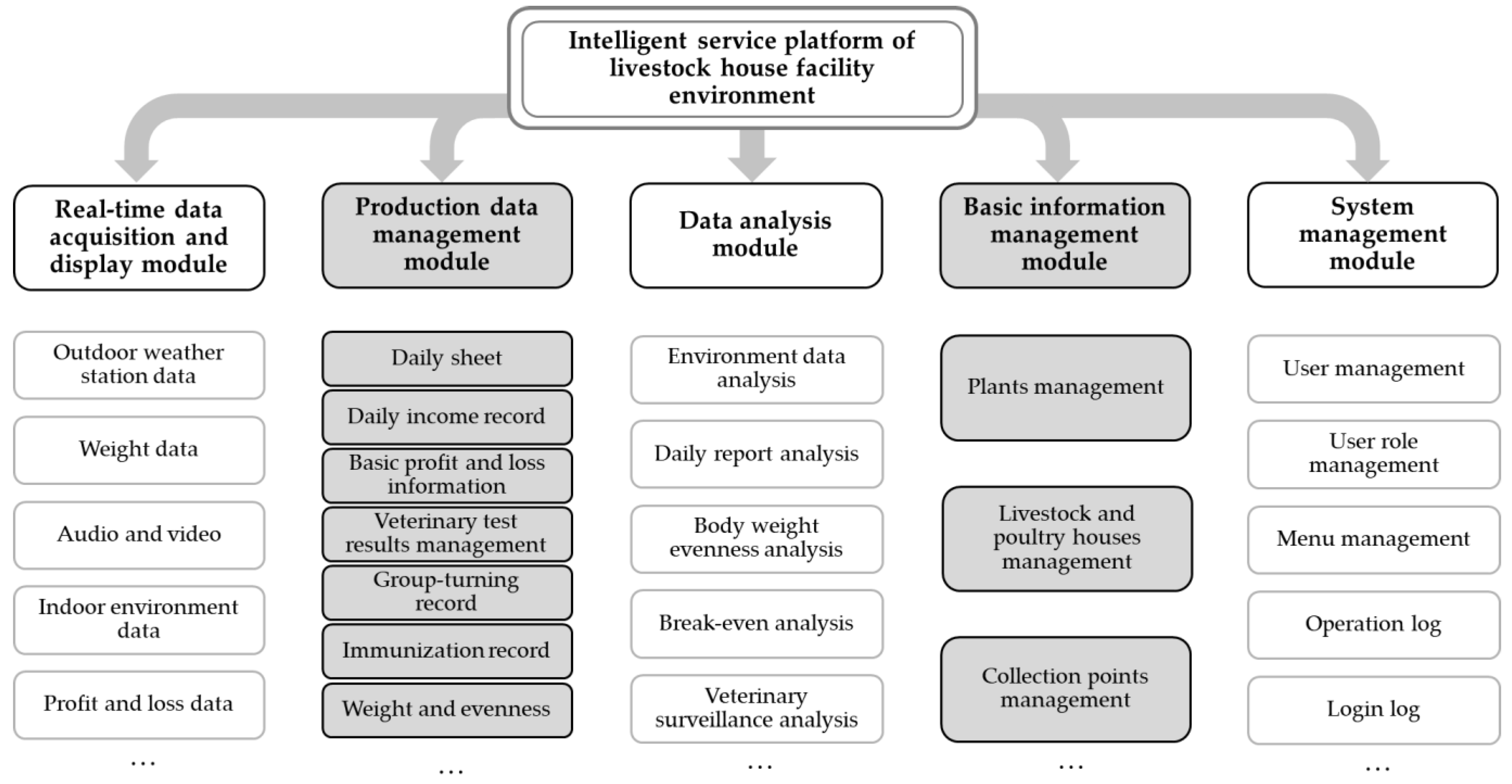



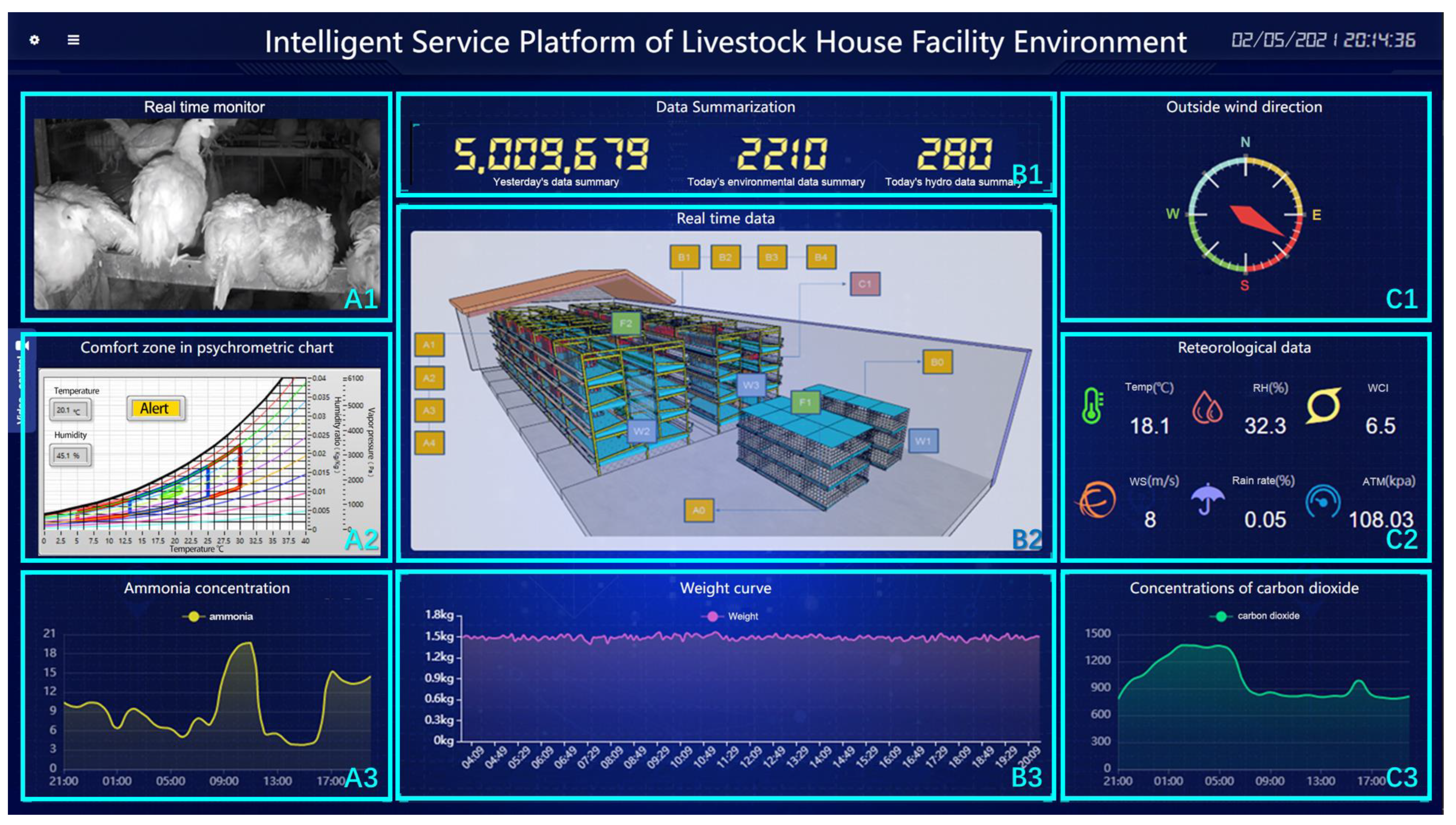



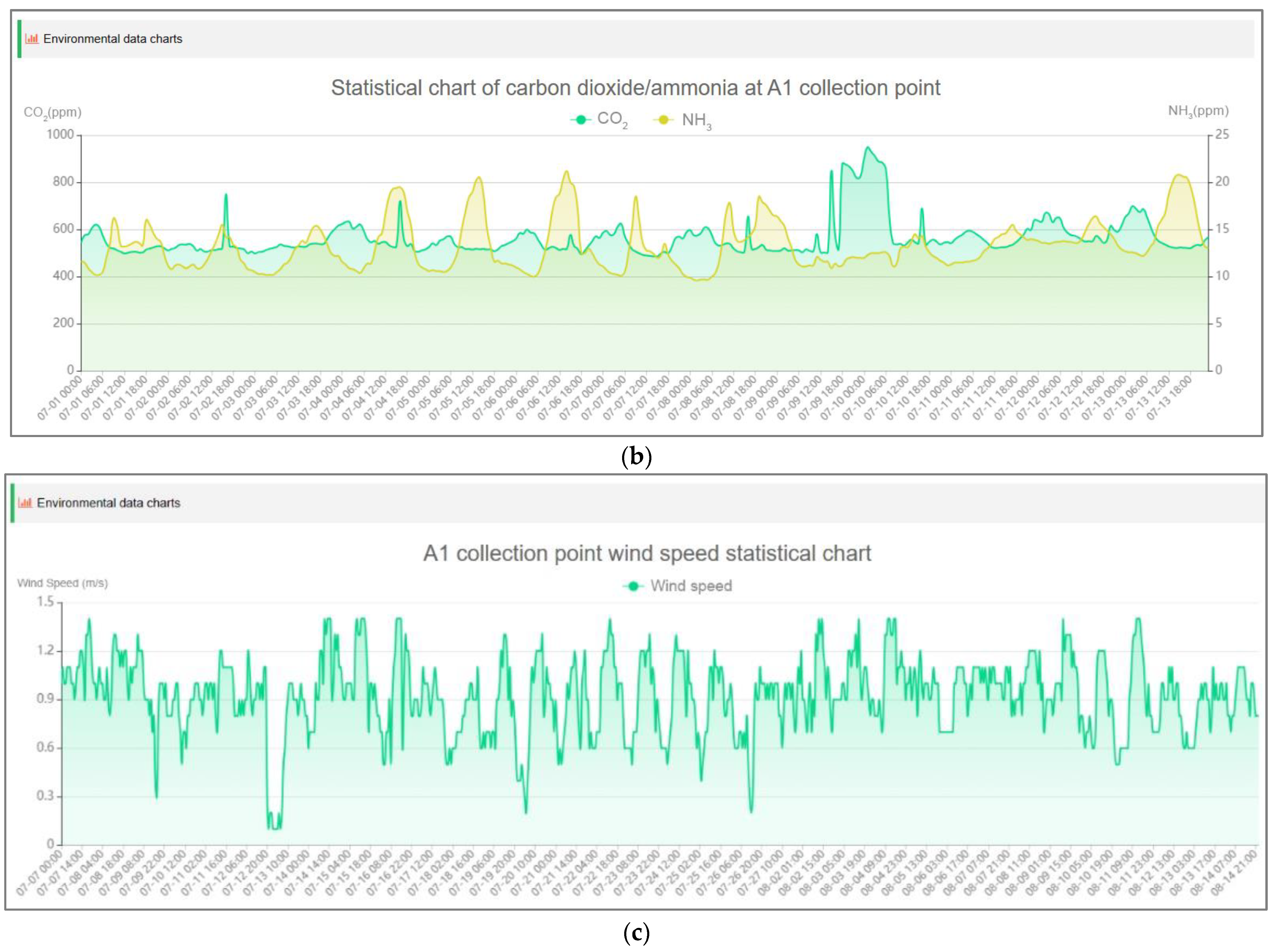
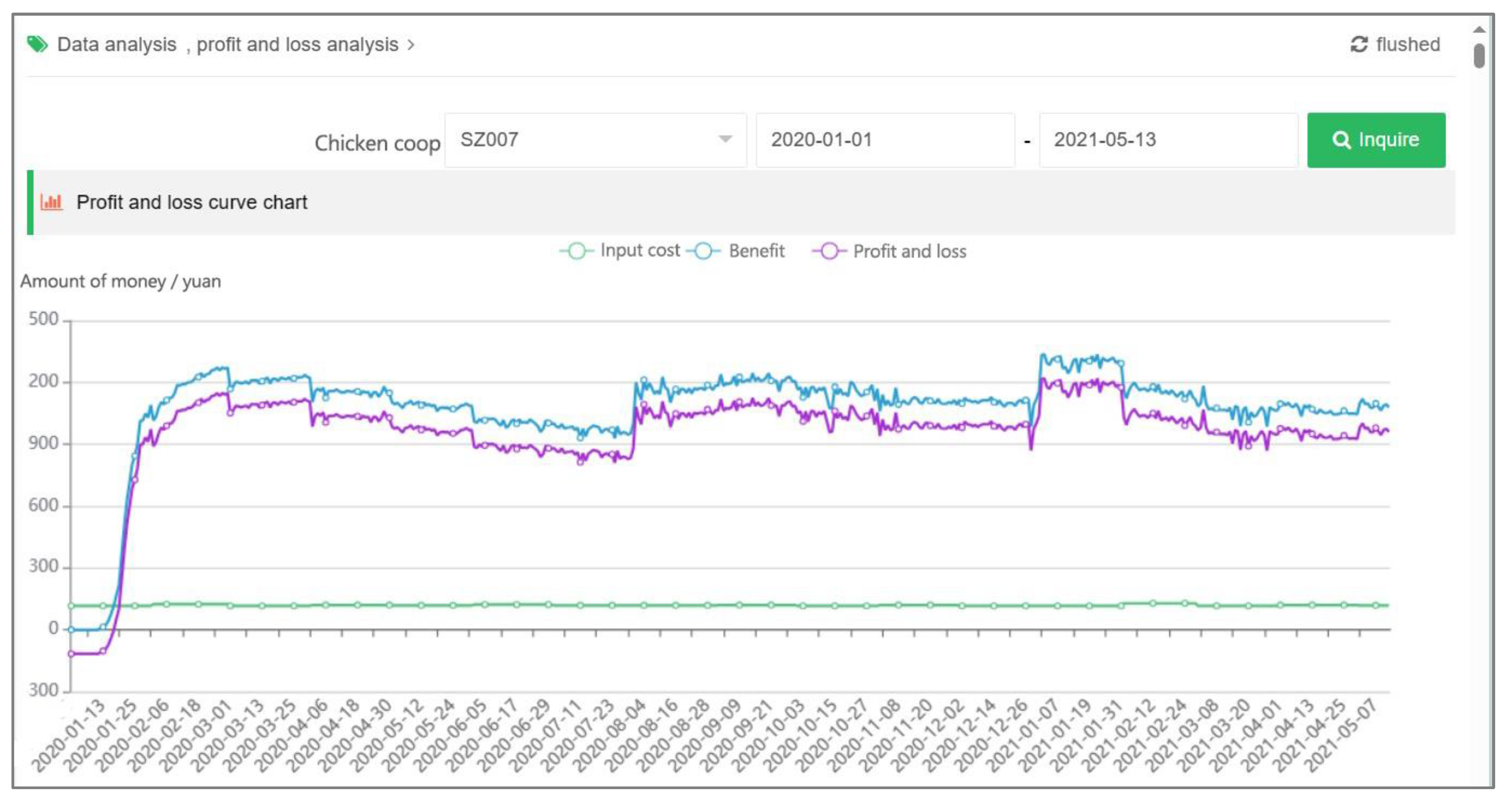
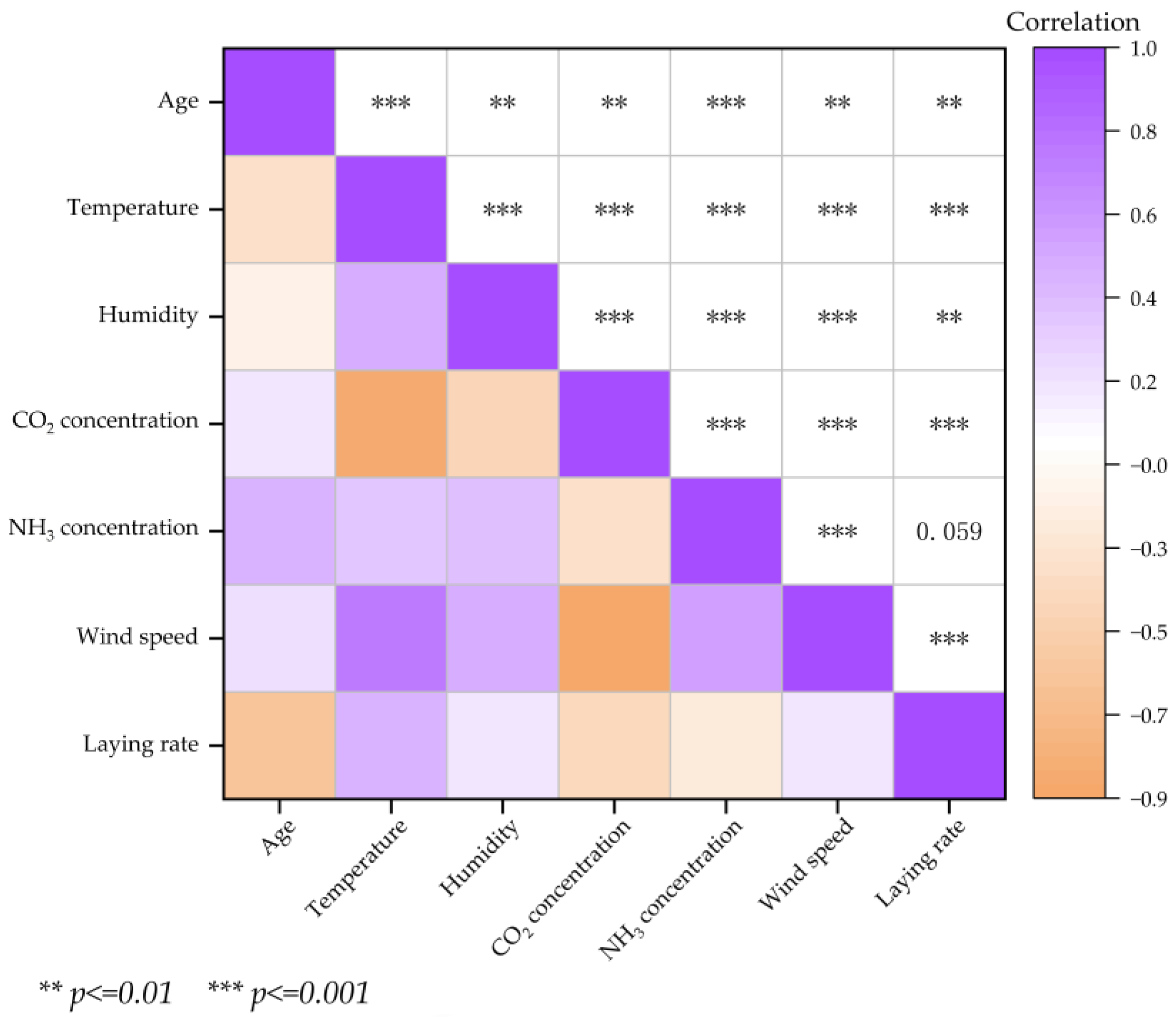
| System Component | Technology Application | Functionality Description | References |
|---|---|---|---|
| Perception Layer | Sound sensors | Monitor chicken welfare level | [10] |
| Digital image sensors | Observe bird conditions | [11] | |
| Near-infrared sensors | Assist in observing birds | [12] | |
| Acceleration sensors | Record intricate chicken movements | [13] | |
| Network Layer | ZigBee wireless sensor network + embedded server | Collect environmental data | [15] |
| LoRa and MQTT communication technology | Develop environmental data acquisition scheme | [16] | |
| 3G communication technology | Design real-time poultry monitoring platform | [17] | |
| 3G + VPN communication technology | Design real-time poultry monitoring platform with enhanced security | [18] | |
| Application Layer | Fuzzy Logic Decision System | Establish decision-making system for livestock control | [19] |
| Business Layer | Cloud computing platform | Form comprehensive digital intelligent monitoring system | [20,21] |
| Remote server infrastructure | Enable seamless remote work | [23] |
| Technology Application | Functionality Description | Pros | Cons | References |
|---|---|---|---|---|
| IoT-Based Weather Monitoring System | Monitoring and notifying deviations in greenhouse weather parameters | Offers ergonomic, power-efficient, and scalable solutions for greenhouse weather monitoring. | Scalability and accuracy improvement challenges | [8] |
| Smart Poultry Management System | Using smart sensors, big data, and IoT tech for monitoring house environment monitor, bird welfare, precision feeding, and disease detection | Enhances production while minimizing costs and resource usage, offering real-time data collection. | Sensors and devices technical problems and data governance | [9] |
| Camera-Based Real-Time Monitoring | Broiler flock welfare, assessing activity and occupation patterns | Correlates activity and occupation patterns with welfare assessments | Latent limitations during dark period | [11] |
| Wireless Activity Sensor Network | Avian influenza monitoring, abnormal states detection | Early chicken abnormal state detection, earlier than body-temperature sensing | false positive detections may be due to bird physiology and movement patterns | [13] |
| Smart Animal Monitoring System | Wireless sensor network and IoT platform for monitoring animal health, and environmental parameter monitoring | Provides continuous mobile surveillance of the entire dairy farm and saves on labor expenses. | Extension needed by adding body-area sensors for capturing animal health data and AI/ML algorithms | [14] |
| IoT-Based Henhouse Monitoring System | Remote henhouse environment monitoring using IoT technology, collecting data through wireless sensors | Using wireless monitoring and environmental factors with high estimation accuracy. | Requires strategies for data loss recovery and missing data filling | [15] |
| Aviary Remote Monitoring System | IoT-based environmental parameter monitoring for poultry farming | Cost-effective and provides real-time monitoring capabilities. | May have limitations in wireless signal range and reliability | [16] |
| 3G-Based Remote Monitoring System | 3G network-based poultry production management system | Reliable environmental parameter monitoring | Dependent on 3G network availability and quality | [17] |
| 3G + VPN Remote Monitoring System | Remote monitoring system based on 3G and VPN, sufficient video bandwidth and cheap wireless network access | Economical, feasible remote monitoring | Currently unable to run uninterrupted, requiring development of automatic reconnection for improved stability | [18] |
| Smart Poultry Management System | precision livestock farming technologies, big data analytics, and IoT-based poultry farming system | Offers real-time monitoring, automated farm procedures, and data-driven decision-making | Requires manual sampling and operation for biosensor-based diagnostics | [20] |
| Cloud-Based Poultry Farming Information Management System | Cloud-based poultry farming information management, including production management and office management modules | Flexibility and scalability data management, enabling data mining and traceability. | Relies on secure and reliable cloud services for data storage and management | [21] |
| Sick Chicken Automatic Detection System | Improved residual network-based sick chicken detection | Improves identification speed and accuracy, saving manpower costs. | Needs extensive training data and computational resources | [25] |
| IoT-Based Environmental Monitoring Instrument | Developed an IoT instrument for monitoring temperature, humidity, light intensity, and ammonia levels in poultry farms. | Low-cost alternative, efficient data recording, and quick data transmission. | IoT connectivity dependence and may need software improvements and additional sensors for air quality maintenance | [26] |
| IoT-Based Intelligent Poultry Environment Control System | IoT-based system for intelligent control of poultry house environments, collecting and analyzing environmental data | Automates environmental data collection and analysis for optimal poultry house conditions. | Requires robust network infrastructure for seamless operation | [27] |
| Deep Belief Network in IoT-Based Agri-System | Agricultural information system using deep belief network | Capable of handling complex data patterns in agricultural settings. | High computational cost and large dataset requirements | [28] |
| Type | Range | Resolution | Accuracy | Model |
|---|---|---|---|---|
| Temperature/°C Relative humidity/% | −20~60 0~100% | 0.1 0.1 | ±0.3 °C ±1.5% | JWSH-5 |
| CO2 concentration/ppm NH3 concentration/ppm | 0~5000 0~500 | 1 0.01 (0~100 ppm), 0.1 (100~500 ppm) | ±(40 ppm + 3%FS *) ±3% | JQAW-3AC JQB-G-NH3-1 |
| Air velocity/m·s−1 | 0~5 | 0.01 | ±(0.2 + 3%FS *) | KL-15G |
| Environmental Data | Raw Data Quantity | Processed Data Quantity | Estimated Data Quantity | Data Integrity * (%) | Data Validity ** (%) |
|---|---|---|---|---|---|
| Temperature | 1,633,590 | 1,628,491 | 1,684,800 | 96.96 | 99.69 |
| Humidity | 1,632,949 | 1,632,022 | 1,684,800 | 96.92 | 99.94 |
| Wind speed | 1,643,868 | 1,553,535 | 1,684,800 | 97.57 | 94.50 |
| Carbon dioxide concentration | 1,466,454 | 1,459,908 | 1,684,800 | 87.04 | 99.55 |
| Ammonia concentration | 796,320 | 770,576 | 842,400 | 94.53 | 96.77 |
Disclaimer/Publisher’s Note: The statements, opinions and data contained in all publications are solely those of the individual author(s) and contributor(s) and not of MDPI and/or the editor(s). MDPI and/or the editor(s) disclaim responsibility for any injury to people or property resulting from any ideas, methods, instructions or products referred to in the content. |
© 2024 by the authors. Licensee MDPI, Basel, Switzerland. This article is an open access article distributed under the terms and conditions of the Creative Commons Attribution (CC BY) license (https://creativecommons.org/licenses/by/4.0/).
Share and Cite
Liu, M.; Chen, H.; Zhou, Z.; Du, X.; Zhao, Y.; Ji, H.; Teng, G. Development of an Intelligent Service Platform for a Poultry House Facility Environment Based on the Internet of Things. Agriculture 2024, 14, 1277. https://doi.org/10.3390/agriculture14081277
Liu M, Chen H, Zhou Z, Du X, Zhao Y, Ji H, Teng G. Development of an Intelligent Service Platform for a Poultry House Facility Environment Based on the Internet of Things. Agriculture. 2024; 14(8):1277. https://doi.org/10.3390/agriculture14081277
Chicago/Turabian StyleLiu, Mulin, Hongxi Chen, Zhenyu Zhou, Xiaodong Du, Yuxiao Zhao, Hengyi Ji, and Guanghui Teng. 2024. "Development of an Intelligent Service Platform for a Poultry House Facility Environment Based on the Internet of Things" Agriculture 14, no. 8: 1277. https://doi.org/10.3390/agriculture14081277





